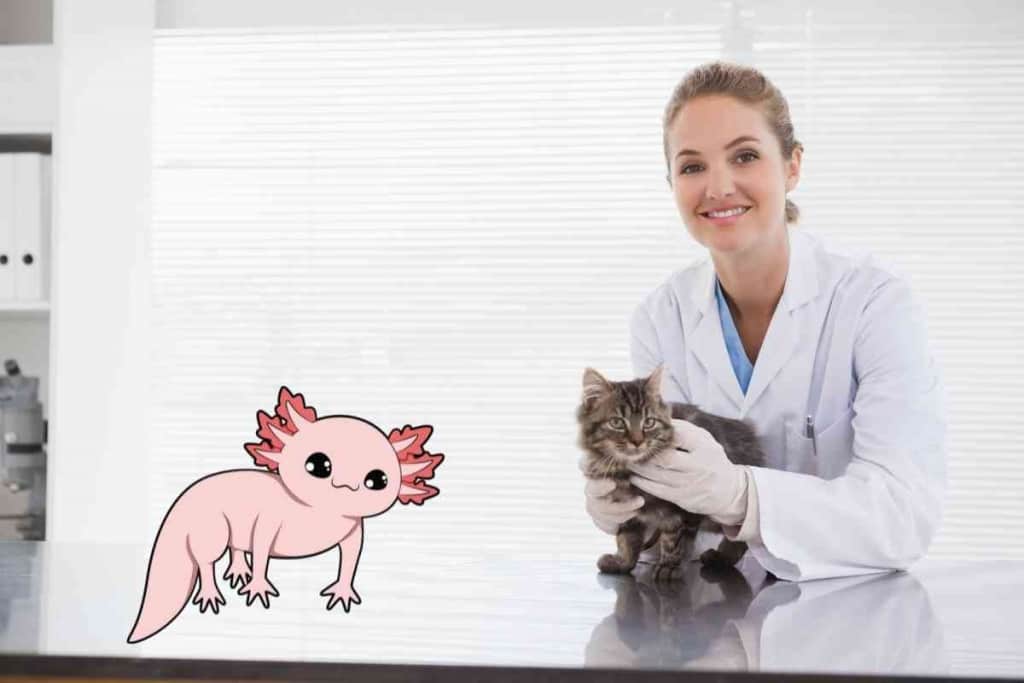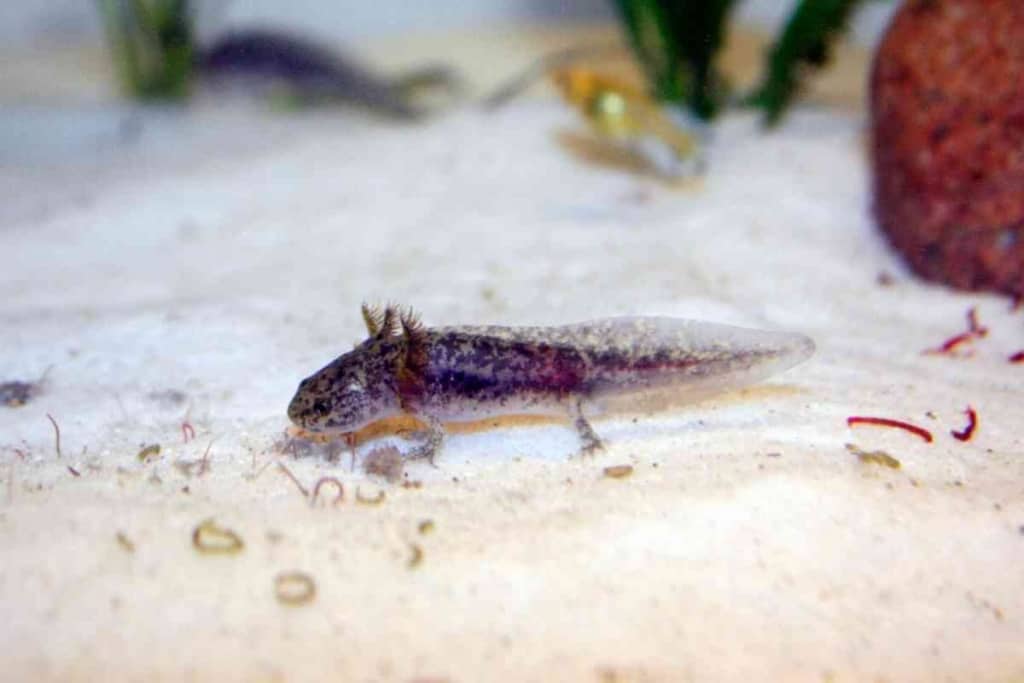Can I Take My Axolotl To The Vet? Is It Worth The Risk?
Axolotls quickly became the internet’s cutest animal, and people have been clamoring to welcome one into their homes. But axolotls aren’t your typical housecat or yard dog, so what do you do when your new friend gets sick? While they are easy to care for and handle, they require a certain level of care to bring them into a vet clinic.

Can I Take My Axolotl To The Vet?
You can and should take your axolotl to an exotic animal vet if you notice any of the tell-tale signs of axolotl health problems. However, because transporting your axolotl to the vet can be stressful and dangerous, it’s important to contact your vet beforehand to ensure the trip is worth the risk.
While a general veterinarian may be able to help your axolotl, it’s best to establish a relationship with a veterinarian who has specialized training in exotics or who at least is very familiar with axolotls.
Taking Your Axolotl to the Vet
Axolotls are generally very healthy animals and quite hardy. And while this can be a boon for new pet owners, axolotls can get worse very quickly when they get sick. So if you notice something off about your axolotl, you first need to call your local exotic pet or specialist veterinarian.
A general veterinarian may be able to help your axolotl, but ultimately you need to see a specialist vet to give your pet the proper care it needs. For example, a veterinarian specializing in fish and amphibians will be able to identify your axolotl’s illness more quickly and suggest the proper treatment for it.
Transportation
However, since amphibians can be difficult to transport, you will want to call your specialist vet before bringing your axolotl in. If they determine that you need to bring your pet in, your vet will most likely detail how to transport your axolotl.
If they don’t, here are some tips for transporting your axolotl. They need to be transported in water, first and foremost, and need to be kept at temperatures below 60℉ (16 ℃). If you transport your axolotl in the middle of summer, you will need to ensure the water doesn’t warm up during transport.
Take a plastic bin and put it in an appropriately sized cooler. Line the inside of the cooler with either ice or frozen water bottles to maintain the plastic bin’s temperature. Fill the bin with cool water and set your axolotl friend inside for safe transport.

Symptoms of Health Issues
Here are some things to watch out for if you suspect that your axolotl is sick or needs to see a vet:
- Lethargic/slow to respond
- Poor appetite
- Gill degeneration
- Curled gills
- Curled tail tip
- Eye lesions (opacity, bulging eyes)
- Skin lesions (excess mucus, hemorrhaging, excess body heat, tumors, ulcers)
- Floating
- Frantic swimming
- Taking frequent gulps of air
Contact your exotic veterinary specialist if you notice your axolotl exhibiting any of these symptoms.
Common Axolotl Health Problems
Bringing your axolotl to the vet is one thing, but knowing when to bring it in is another. Axolotls are incredibly resilient but are very sensitive to changes in water quality. If you notice your axolotl behaving abnormally, it could have one of the following health issues.
New Tank Syndrome
When introducing your axolotl to a new tank, you must be careful with changing the water and tank filter. If the biofilter doesn’t function properly or hasn’t been run before your new friend’s arrival, it can cause ammonia and nitrate in the water to rise to toxic levels. Check to ensure that your biofilter is intact and functioning properly before contacting a veterinarian.
Ammonia Poisoning/Burns
Ammonia buildup is another thing to watch out for. Ammonia builds up from waste in the tank and can be toxic for axolotls. If your axolotl turns red and its gills deteriorate, these are sure signs that it has ammonia burns.
This is important to treat as soon as possible since ammonia burns can lead to respiratory problems and neurological damage.
Bacterial or Viral Infections
It’s important to keep your axolotl tank clean and sanitary. If you notice that your pet is lethargic or not eating as much, it can indicate an infection. Regular cleaning will help minimize any infections your axolotl has. However, you must be careful using harsh chemicals to clean your pet’s tank.
Parasitic Infections
Axolotls may get infected with parasites if you feed them live fish. In general, you shouldn’t be feeding your pet live fish.
But you should avoid the practice since introducing these animals can lead to infections and disease. If your pet’s appetite changes dramatically or its coloration changes without prompting, it may have parasites.
Physical Injuries and Abnormalities
Axolotls are known to regenerate body parts after a physical injury. Mixed-gender tanks will also see males and females fighting during mating seasons.
If your axolotl loses a limb or injures itself, you must take proper care of it (potentially with medical assistance). Before you attempt to treat any wounds or amputations, speak with your specialty vet first. If treated improperly, your pet may not be able to regenerate and heal naturally.
Metamorphoses
While metamorphoses don’t often occur in axolotls, they can be extremely stressful times. If you notice abnormal changes in your pet, including unusual growth spurts, contact your vet immediately.
Preventative Measures
Any good pet owner wants to avoid an emergency trip to the vet as much as possible. Preventative care and maintenance will go a long way to protect your axolotl from health scares and unwanted health issues. Here are some things you can do to keep your pet happy and healthy.
Keep Tank Clean of Gravel
While gravel and small rocks make great additions to your tank, axolotls may try to eat them or will ingest them accidentally. Depending on the situation, this can lead to even more health problems and potential surgery. As a general rule of thumb, don’t purchase any tank decorations that are smaller than your axolotl’s head.
No Sharp Objects
This should go without saying, but you shouldn’t decorate your axolotl’s tank with sharp objects. They may swim into these objects and injure themselves.
Unsafe Dyes
Make sure to read the sand and tank decor labels for unsafe ingredients. If all ingredients are marked as safe for aquatic pets, then it should be okay to use for your axolotl.
Aggressive Tank Mates
Some fish have been known to be very aggressive with axolotls or accidentally mistake them for food. Ask your vet or fish store owner before integrating a new fish into your aquarium, and make sure that you get your axolotl a friend that will coexist with it peacefully.
Keep the Tank Clean
And finally, the best way to keep your axolotl healthy is to keep its habitat clean. Axolotls are particular about their water temperature and environment, but proper hygiene will go a long way.
